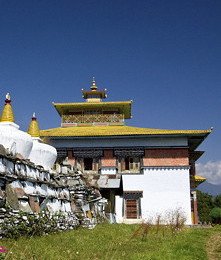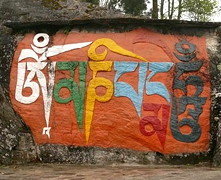
Tashiding Bumchu
In the eighth century, Tibet's religious king Trisong Deutsen (Khri srong lde'u btsan) requested Guru Rinpoche to teach him a meditation practice that would allow him to reach enlightenment in his present life. He explained that due to his administrative responsibilities as head of state, he had little time left for meditation and was anxious to learn a short but effective practice. Guru Rinpoche agreed to initiate King Trisong Deutsen in a practice, which would help him gain emancipation from the cycle of mundane existence, known as the Thugs rje chen po 'khor wa las grol. However, in order to perform the initiation, Guru Rinpoche asked for a vase made of special earth, water and five kinds of gems (rin chen sna lnga) collected from all over the world. When Trisong Deutsen explained that he was unable to produce such a vase, Guru Rinpoche agreed to collect the precious materials from India, Odiyana, and Zahor and instructed the wrathful Dharmapala Damchen Garnag (Dam chen mgar nag) to fashion the object. When the wrathful Dharmapala presented the finished vase to Guru Rinpoche, he invoked Chenrezig's (spyan ras gzigs) blessing and empowerment to hold the initiation. While he initiated King Trisong Deutsen and his son, Prince Murub Tsenpo, Yeshe Tsogyal and disciple Verotsana, Guru Rinpoche consecrated the Bumchu, or sacred vase, which is the very same one that is preserved in Tashiding monastery to this day.
According to the works of the great Terton Chokyi Gyalpo Garwang Rigdzin Zhigpo Lingpa (gter ston chos kyi rgyal po gar dbang rig 'dzin zhig po gling pa, 1524 - 1588), while Guru Rinpoche performed the sadhana of Yidam Chuchig Zhal (yi dam bcu gcig zhal) as part of the initiation, the Yidam and the entire retinue of deities appeared in the sky and immersed in the water contained in the vase. This caused the sacred water to overflow and spread in all directions in the form of rays. That very moment, as a good omen, there was an earthquake and the four Dharma protectors and gods of the thirty-three heavens showered flowers from the sky. This spectacular event was witnessed by the people who were assembled there who were overjoyed, and sacred water from the vase was distributed to all. Yet, it was found that the water in the vase never decreased. Inspired by this, the sinful became virtuous, the pious realized lofty divine qualities and all benefited spiritually. Finally, Guru Rinpoche concealed the Bumchu as a sublime hidden treasure and entrusted it to the protective deities.
In the sixteenth century, Zhigpo Lingpa, the reincarnation of Prince Murub Tsenpo who had attended the first initiation, unearthed the initiation text and the Bumchu for the sake of all sentient beings from a monastery in Lhasa (ra sa 'phrul snang gi gtsug lha khang). After the vase's discovery, Terton Zhingpo Lingpa adopted Chenrezig, the deity of the same sadhana as his tutelary deity (thugs dam rtan). During the latter part of his life, he offered it to Terton Tagshamchen (sTag gsham can 1556 - ?) of Ngari with special instructions. Terton Tagshamchen then entrusted the Bumchu to his grandson Ngadag Sempa Chenpo Phungtsog Ringzin instructing him to install it at Drakar Tashiding, where it was to be kept in the heart of the most blessed hidden land of Guru Rinpoche. Thus, Ngadag Sempa Chenpo brought the Bumchu to Tashiding and installed it in the main temple known as the Tashi Geleg Gon (bkra shis dge legs dgon). He then conducted a special recitation of 13 million syllables 'om mani padme hung' following the same Thugs rje chen po 'khor wa las grol text. At that time, many unprecedented and auspicious signs appeared in the sky.
The Bumchu and its sacred water are kept in a miniature mansion (mchod bsham) under lock and seal of the Chogyal of Sikkim and the lama committee of Tashiding. Every year, a special recitation is conducted and the seal is checked by the high officials and lamas before the Bumchu is taken out of its mansion. The Bumchu is opened during the night of the 14th day of the first month of the lunar calendar, and three cups of water are taken from it. The first cup is for the royal family, the second for the lamas and the third to be distributed among the pilgrims on the day of the full moon. The three cups are replaced with water brought from Rathong Chu, which is also considered a blessed river.
In some years, the Bumchu's sacred water increases by 21 cups while in others it decreases or remains at the same level. It may also be found to be clear or cloudy, states that are interpreted as predictions for the country. When the water level increases, it is a sign of prosperity and when it decreases, it predicts a bad year of drought and disease. Cloudy water indicates conflict and unrest.
It is said that the seed of enlightenment may be obtained by drinking a mere drop of the Bumchu water. By this action, all distress, malevolent beings and untoward happenings are removed, prosperity and fulfilment are awarded in this life, and one may attain Buddhahood or be born in the Riwo Potala (ri bo po ta la), the heaven of Chenrezig or of Zangdogpalri (zangs mdog dpal ri), the heaven of Guru Rinpoche, in the following life.
Resource: Rigzin Ngodup Dokhampa - Origins of the Bumchu of Drakar Tashiding

Tashiding Monastery

Stupas at Tashiding

Mantra of Chenrezig
on a wall in Tashiding